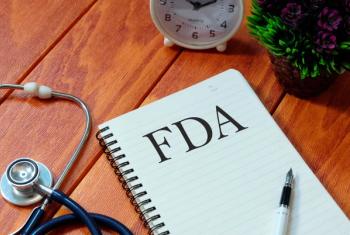
Refractory Bedwetting Pinned to Abnormal Prostaglandins
AARHUS, Denmark -- Bedwetting not controlled by standard therapy may be caused by excess sodium and urea excretion, possibly brought on by a surfeit of prostaglandin E2, suggested researchers here.
AARHUS, Denmark, Dec. 1 -- Bedwetting not controlled by DDAVP (desmopressin) may be caused by excess sodium and urea excretion, possibly brought on by a surfeit of prostaglandin E2, suggested researchers here.
In an overnight study comparing seven- to 14-year-olds with nocturnal enuresis with dry controls, the children with enuresis plus nocturnal polyuria excreted significantly greater amounts of sodium and urea at night than either nonpolyurics or controls, found Konstantinos Kamperis, M.D., of the University of Aarhus, and colleagues.
These children were also found to excrete prostaglandin E2 at significantly higher levels, the authors wrote in the December issue of the American Journal of Physiology-Renal Physiology.
The findings point to overzealous prostaglandin synthesis as a possible explanation for at least some of the approximately 30% of cases of nocturnal enuresis that are resistant to DDAVP.
"Renal prostaglandins have emerged as a possible key molecule in the etiology of enuresis-related polyuria, and it has been demonstrated that children with DDAVP-resistant enuresis nocturna may excrete larger amounts of prostaglandin E2 , the major renal autacoid, in urine," they wrote.
"Because prostaglandin synthesis inhibition effectively treats bed-wetting, it seems reasonable to suggest a role for prostaglandins in the physiological mechanisms causing monosymptomatic nocturnal enuresis."
The authors assessed how the renal system handles water and solutes in children with monosymptomatic nocturnal enuresis (both with and without polyuria), and in healthy controls.
To do this, they admitted volunteers for a 24-hour study in which water and sodium intake could be monitored and controlled. The participants included 46 children ages seven to 14 with enuresis, and 15 age-matched controls. The cohort included children with severe enuresis, defined as 5 + 1 wet nights per week, with a less than 50% reduction in wet nights with DDAVP treatment.
The participants were followed with urine collections, blood sampling, and blood pressure monitoring. Plasma samples were evaluated for sodium, potassium, creatinine, urea, osmolality, atrial natriuretic peptide, angiotensin II, aldosterone, and activated renin. Urine samples were analyzed for sodium, potassium, urea, creatinine, osmolality, arginine vasopressin, prostaglandin E2, and aquaporin-2.
Children with enuresis were categorized according to urine output, with polyuria defined as average nocturnal output on wet nights exceeding 130% of expected bladder capacity.
The investigators found that the children with nocturnal polyuria excreted larger amounts of sodium and urea at night than either nonpolyurics or controls.
Levels of solute-free water reabsorption, urinary arginine vasopressin and aquaporin-2 excretion were all normal in the polyuric children, and there were no significant differences among children with enuresis and controls in atrial natriuretic peptide, angiotensin II, aldosterone, or renin levels.
Where they did find a difference, however, was in levels of urinary prostaglandin E2, which were significantly higher among the children with enuresis and polyuria.
They also found that urine from bedwetting episodes in the patients with nocturnal polyuria was significantly less concentrated than the urine from the same patients collected in the first morning voids.
"When we look at what happens in the last hours of the night, we couldn't find any differences," Dr. Kamperis said. "The first hours are most important."
An important finding of their study, the authors wrote, is that patients with nocturnal polyuria excrete larger amounts of sodium and urea at night compared with controls and nonpolyurics, despite having normal renal water handling rhythms, and normal urine excretion profiles of arginine vasopression and aquaporin-2.
"This natriuresis found in polyurics does not seem to reflect abnormalities in either hemodynamics or the circadian rhythm of sodium-regulating hormones such as atrial natriuretic peptide, aldosterone, angiotensin II, and renin, but may be secondary to augmented excreted prostaglandin E2, as became evident in the population of polyurics," they continued. "This excess prostaglandin E2 generation found in this subgroup of enuretics may also be responsible for the failure of DDAVP to control their polyuria."
Thus, prostaglandin E2 directly influences renal tubular sodium handling, exerting potent natriuretic properties. The authors found a significant correlation between excretion of prostaglandin E2 and urinary sodium excretion consistent with this as a potential mechanism for the increased sodium excretion.
Furthermore, because prostaglandin E2 blocks the renal effects of AVP through cAMP downregulation the high luminal prostaglandin E2 levels may be related to the failure of dDAVP to effectively diminish the nocturnal urine output in these children.
The investigators have begun a placebo-controlled trial of the prostaglandin E2 synthesis inhibitor Indocin (indomethacin) in children with DDVAP-resistant nocturnal enuresis.
Newsletter
Enhance your clinical practice with the Patient Care newsletter, offering the latest evidence-based guidelines, diagnostic insights, and treatment strategies for primary care physicians.



















































































































































































































































































